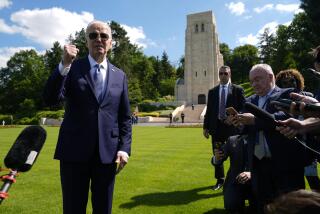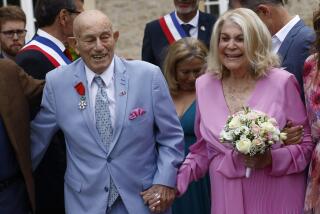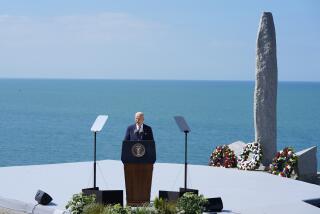French Honor the Doughboys as 18 Return
MARNES-LA-COQUETTE, France — In solemn ceremonies attended by 18 American veterans in their 80s and 90s, France on Sunday commemorated the 70th anniversary of the entry of American doughboys into World War I, an event that ensured the victory of the Allied forces over Kaiser Wilhelm’s Germany.
“It’s the first time I’ve come back since then,” said 90-year-old Harold Ogden of Fairfax, Va. “France is beautiful. You know, we didn’t have time to see how beautiful it was during the war.”
Ogden and two other veterans, 89-year-old Winston M. Roche of North Hollywood and 87-year-old Herbert M. Houston of Chattanooga, Tenn., received the decoration of the French Legion of Honor and kisses on both cheeks from French Minister of Defense Andre Giraud.
The arrival of the doughboys--the American nickname for American infantrymen during World War I--is probably looked on as a more significant event in French history than in American history, for the carnage of that war still sears the national consciousness of France. The fighting and the havoc it wrought claimed the lives of more than 12.6 million soldiers and civilians on both sides, including about 1.4 million Frenchmen who were killed in combat.
French historians believe that the arrival of the Americans--who were known in France as Sammies, because of the American symbol Uncle Sam, or Boy Scouts, because of their odd, wide-brimmed hats--gave France an enormous psychological boost.
The American entry into the war is being commemorated in France this year by a new stamp, a commemorative medal from the national mint, a symposium at the University of the Sorbonne, an exhibition in Paris, several celebrations in areas where the doughboys fought and the national ceremonies here in Marnes-la-Coquette, southeast of Paris.
Many posters in Paris, like the stamp and medal, feature a likeness of Gen. John J. Pershing, the commander of the American Expeditionary Force, and the famous quotation that is usually but erroneously attributed to him, “Lafayette, nous voila!” (Lafayette, we are here!). An aide to Pershing made the remark, which implied that the Americans were repaying the debt owed to France for the help of the Marquis de Lafayette during the American Revolutionary War.
The Legion of Honor
In the ceremonies, Ogden, Roche, and Houston were singled out for the Legion of Honor because of their war records. The other veterans, including Mary Hallock, the head American nurse in Europe during the war, received a lesser distinction, the French national order of merit.
“I was gassed twice during the war,” said Roche, who worked as an engineer for the Los Angeles recreational department for 33 years. “It was awful. I still have problems with my throat.”
Roche, who came to France as “a buck private all the way in the back,” was eventually commissioned and finally became a colonel before leaving the Army after a second tour during World War II.
“I was in the first convoy that landed in June, 1917,” Houston said. “Our big problem was trying to read the newspapers. Everything was in French. We couldn’t read French when we came, and we couldn’t read it when we left.”
The national ceremonies Sunday were held in the park in Marnes-la-Coquette that encloses the huge memorial to the Lafayette Escadrille, the American aviators who volunteered to fly for France even before the United States entered the war.
“How do you find a symbol more dazzling?” asked Defense Minister Giraud in a speach.
Dressed in WWI Uniforms
The commemoration featured 20 American soldiers dressed in the old uniforms of the doughboys, 20 French soldiers dressed in the uniforms of the poilus (or the unshaven, as French infantrymen were known during the war), a flyover by four modern French Mirage jet fighters, four modern American F-15 jet fighters and three French biplanes of World War I vintage.
French officials had given up on the biplanes when they finally flew over the memorial. The crowd, waiting patiently for 20 minutes for the arrival of the old planes, burst into laughter when a formation of three ducks flew overhead instead. An official then announced that the antique French fighters--a Breguet 14 and two SE-5s--could not take to the air because of the cloudy weather.
A few moments later, however, the World War I planes lumbered overhead to enthusiastic applause.
The flight and the ceremonies recalled some fascinating history. When the United States declared war on Germany in April, 1917, France, which had been fighting for three years, was in a somber mood. Defeatism was rampant. After the long months in murderous trenches, small groups of French soldiers had mutinied in 60 divisions. Many French wondered whether they had the strength to continue fighting.
Only Source of Optimism
The entry of the Americans into the war became the only source of optimism. Gen. Pershing arrived in Paris on June 13, and the first convoy of troops landed in Saint Nazaire on the Atlantic coast two weeks later. Before his troops arrived, Pershing took part in a series of public relations exercises, appearing at rounds of dinners and ceremonies, laying a wreath at the tomb of Lafayette, all to drive home to the French that help was on its way. At the request of the government, French newspapers wrote incessantly about the American troops.
Before the end of the war in November, 1918, the Americans, in an extraordinary feat of mobilization, had sent 2 million troops to fight under Pershing in Europe. Although French military historians have often belittled the direct contribution of these Americans to the victory, Andre Kaspi, a historian at the University of the Sorbonne, wrote in a recent article that the American reservoir of reinforcements enabled Marshal Ferdinand Foch to launch his decisive counteroffensive in the summer of 1918.
On top of this, the Americans lent France and the Allies huge sums of money and supplied them with enormous quantities of wheat, cotton, steel and oil.
“The United States,” wrote Kaspi, “brought the indispensable aid that made the victory of November, 1918, possible.”
WWII Suspension
After World War I, a tradition developed in France of commemorating the anniversary of the arrival of the American doughboys. But during World War II, when France was occupied by Nazi German troops and ruled by the fascist, collaborationist Vichy government, the commemoration was suspended.
After the war, the memory of the American D-Day landings in Normandy was so vivid that it tended to obscure the memories of the American participation in World War I. In 1967, for example, there was no national anniversary ceremony. A few cities commemorated the event on their own.
In 1987, during an era of extraordinary good French feelings about the United States, the French government decided to revive the old tradition and commemorate an event that was so crucial for the outcome of World War I.
More to Read
Sign up for Essential California
The most important California stories and recommendations in your inbox every morning.
You may occasionally receive promotional content from the Los Angeles Times.










